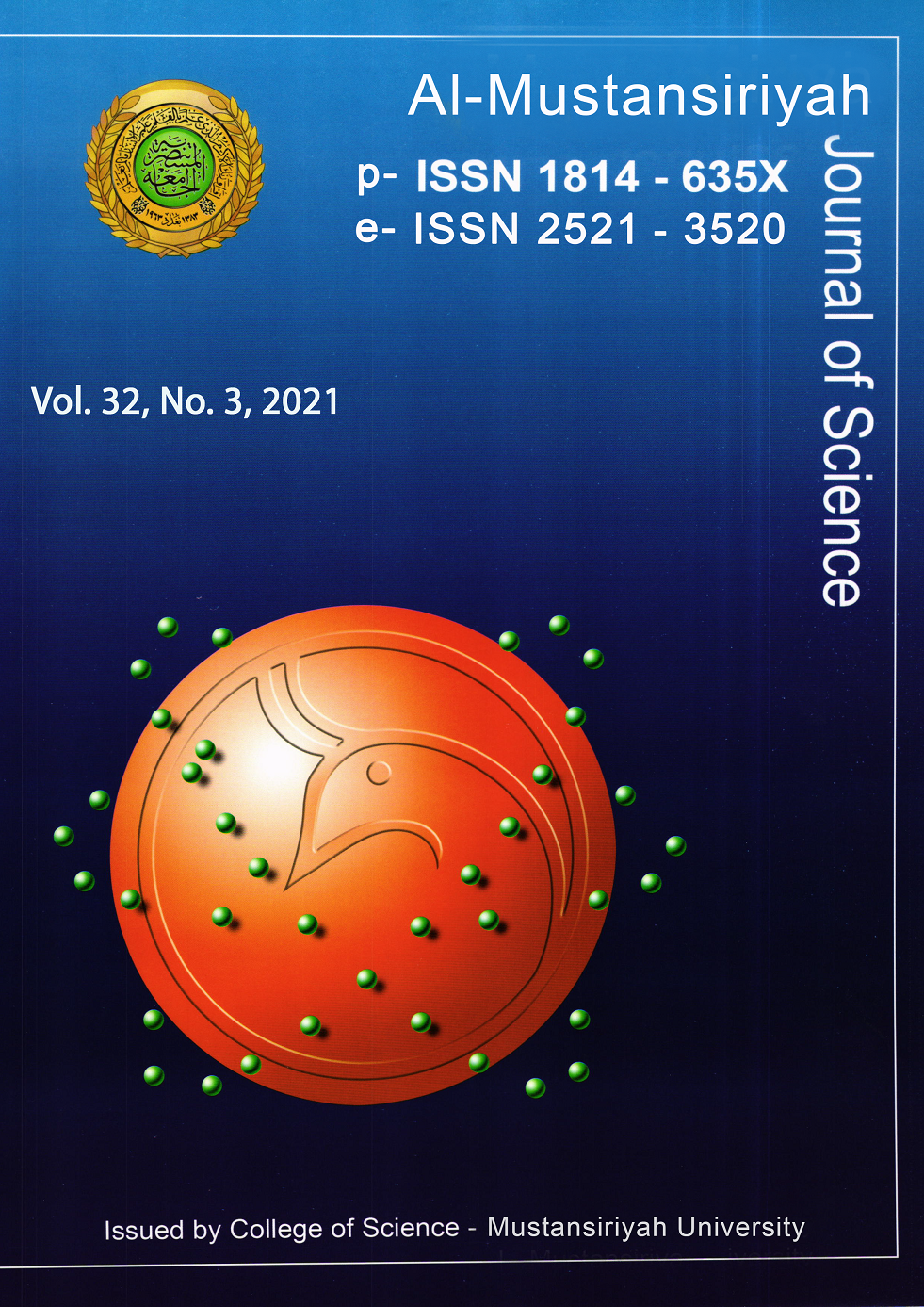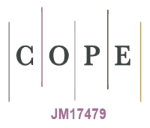Optical and Electrical Conductivity of SnO:Cu Nanoparticles
DOI:
https://doi.org/10.23851/mjs.v32i3.944Keywords:
optical conductivity, electrical conductivity, RF sputters, Roughness, Line histogram.Abstract
This study included a different weight ratio of copper (2, 4, 6, 8) wt% as a dopant, with tin oxide SnO2 deposits on glass substrate by RF reactive magnetron sputter. The structural properties show polycrystalline pattern nature for all deposit samples with dominated reflection (110). The electrical conductivity increased to 1×13010 S-1 and the optical conductivity to 35×1016 S-1. The energy gap decreased to 3.60 eV when the rate of deformation was 8wt%, due to the increase in the crystallite size to 24.5 nm with the improvement of crystallization. While the surface measurements showed an increase in the surface roughness to 50 nm when the rate of deformation at 8wt%.Downloads
References
O. Abdulmunem, K. Hassoon, M. Gaafar, A. Rahimi-Iman, and J. C. Balzer, "TiN Nanoparticles for Enhanced THz Generation in TDS Systems," J. Infrared, Millimeter, Terahertz Waves, vol. 38, no. 10, pp. 1206-1214, 2017, doi: 10.1007/s10762-017-0412-z.
Mohammed Ali Mohammed Jassim, J. M. Chauveau, and T. Bretagnon, "Time-resolved photoluminescence investigation of (Mg, Zn) O alloy growth on a non-polar plane," Superlattices Microstruct., 2018, doi: 10.1016/j.spmi.2018.02.001.
S. J. Mezher, K. J. Kadhim, O. M. Abdulmunem, and M. K. Mejbel, "Microwave properties of Mg-Zn ferrite deposited by the thermal evaporation technique," Vacuum, vol. 173, p. 109114, Mar. 2020, doi: 10.1016/j.vacuum.2019.109114.
A. K. H. Albarazanchi, A. Al‐Haddad, and M. F. Sultan, "Plasmonic Enhancement Mechanism of Template‐Based Synthesized Au@TiO2 Nanodiscs," ChemNanoMat, vol. 7, no. 1, pp. 27-33, Jan. 2021, doi: 10.1002/cnma.202000513.
C. A. Hoel, T. O. Mason, J. F. Gaillard, and K. R. Poeppelmeier, "Transparent conducting oxides in the ZnO-In2O3-SnO2 system," Chem. Mater., vol. 22, no. 12, pp. 3569-3579, 2010, doi: 10.1021/cm1004592.
T. Minami, "Transparent conducting oxide semiconductors for transparent electrodes," Semicond. Sci. Technol., vol. 20, no. 4, 2005, doi: 10.1088/0268-1242/20/4/004.
E. Elangovan, M. P. Singh, M. S. Dharmaprakash, and K. Ramamurthi, "Some physical properties of spray deposited SnO2 thin films," J. Optoelectron. Adv. Mater., vol. 6, no. 1, pp. 197-203, 2004.
E. S. Hassan, A. N. Abd, and M. O. Dawood, "The Sputter Time Duration Effect on the Structural and Optical Properties of Zinc Oxide by RF Magnetron Sputtering," Silicon, vol. 10, no. 6, pp. 2901-2906, 2018, doi: 10.1007/s12633-018-9831-2.
J. C. Manifacier, M. De Murcia, J. P. Fillard, and E. Vicario, "Optical and electrical properties of SnO2 thin films in relation to their stoichiometric deviation and their crystalline structure," Thin Solid Films, vol. 41, no. 2, pp. 127-135, 1977, doi: 10.1016/0040-6090(77)90395-9.
M. M. Bagheri-Mohagheghi and M. Shokooh-Saremi, "The influence of Al doping on the electrical, optical and structural properties of SnO2 transparent conducting films deposited by the spray pyrolysis technique," J. Phys. D. Appl. Phys., vol. 37, no. 8, pp. 1248-1253, 2004, doi: 10.1088/0022-3727/37/8/014.
A. F. Khan, M. Mehmood, A. M. Rana, and M. T. Bhatti, "Effect of annealing on electrical resistivity of rf-magnetron sputtered nanostructured SnO 2 thin films," Appl. Surf. Sci., vol. 255, no. 20, pp. 8562-8565, 2009, doi: 10.1016/j.apsusc.2009.06.020.
A. J. Galdikas et al., "Peculiarities of surface doping with Cu in SnO2 thin film gas sensors," Sensors Actuators, B Chem., vol. 43, no. 1-3, pp. 140-146, 1997, doi: 10.1016/S0925-4005(97)00206-2.
S. M. A. Durrani, "Biasing voltage dependence of sensitivity of electron beam evaporated SnO2 thin film CO sensor," Sensors, vol. 6, no. 9, pp. 1153-1160, 2006, doi: 10.3390/s6091153.
B. K. Min and S. D. Choi, "SnO2 thin film gas sensor fabricated by ion beam deposition," Sensors Actuators, B Chem., vol. 98, no. 2-3, pp. 239-246, 2004, doi: 10.1016/j.snb.2003.10.023.
S. Shukla, V. Venkatachalapathy, and S. Seal, "Thermal Evaporation Processing of Nano and Submicron Tin Oxide Rods," J. Phys. Chem. B, vol. 110, no. 23, pp. 11210-11216, Jun. 2006, doi: 10.1021/jp061009b.
S. S. Chiad, H. A. Noor, O. M. Abdulmunem, and N. F. Habubi, "Optical and structural properties of Ni-doped Co3O4 Nanostructure thin films via CSPM," J. Phys. Conf. Ser., vol. 1362, no. 1, 2019, doi: 10.1088/1742-6596/1362/1/012115.
D. G. Rickerby and A. M. Serventi, Nanostructured Metal Oxide gas sensors for air-quality monitoring, 1st ed. Elsevier, 2010.
S. Tarish et al., "Highly efficient biosensors by using well-ordered ZnO/ZnS core/shell nanotube arrays," Nanotechnology, vol. 28, no. 40, p. 405501, Oct. 2017, doi: 10.1088/1361-6528/aa82b0.
R. Brahma, M. G. Krishna, and A. K. Bhatnagar, "Optical, structural and electrical properties of Mn doped tin oxide thin films," Bull. Mater. Sci., vol. 29, no. 3, pp. 317-322, 2006, doi: 10.1007/BF02706503.
R. A. Afre, N. Sharma, M. Sharon, and M. Sharon, "Transparent conducting oxide films for various applications: A review," Rev. Adv. Mater. Sci., vol. 53, no. 1, pp. 79-89, 2018, doi: 10.1515/rams-2018-0006.
P. Chetri, B. Saikia, and A. Choudhury, "Structural and optical properties of Cu doped SnO2 nanoparticles: An experimental and density functional study," J. Appl. Phys., vol. 113, no. 23, 2013, doi: 10.1063/1.4811374.
Downloads
Key Dates
Received
Accepted
Published
Issue
Section
License
Copyright (c) 2021 Al-Mustansiriyah Journal of Science

This work is licensed under a Creative Commons Attribution 4.0 International License.
(Starting May 5, 2024) Authors retain copyright and grant the journal right of first publication with the work simultaneously licensed under a Creative Commons Attribution (CC-BY) 4.0 License that allows others to share the work with an acknowledgement of the work’s authorship and initial publication in this journal.






















